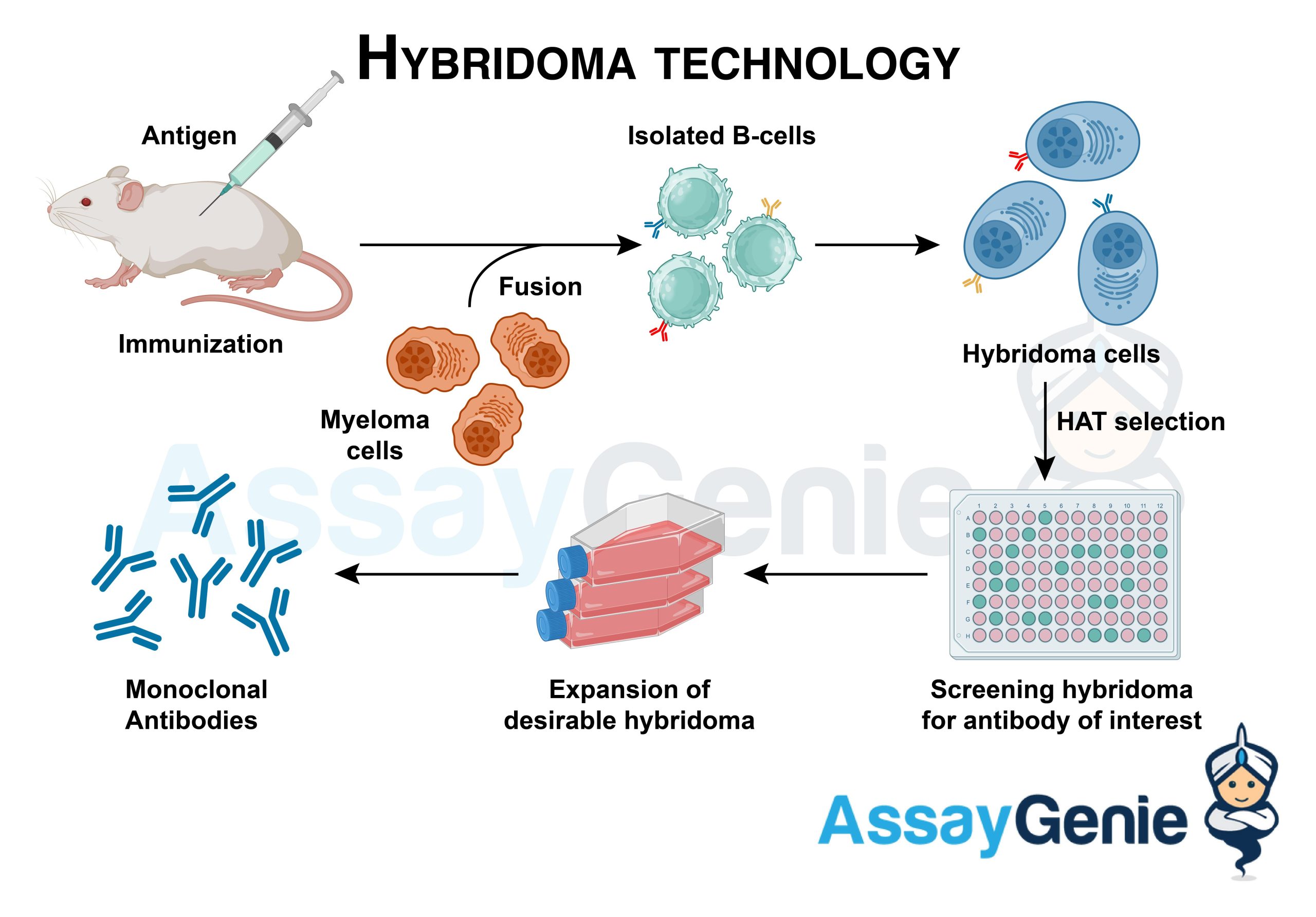
What is a hybridoma and its role in antibody production

In the realm of biomedical research and therapeutic development, the ability to produce antibodies has proven to be invaluable. One of the key innovations in this area is the production of monoclonal antibodies through the hybridoma technique. This method allows researchers to create specific and uniform antibody populations that can target particular proteins or antigens, making it easier to diagnose diseases and develop treatments. A hybridoma is a hybrid cell that possesses the qualities of both a myeloma cell and a B-cell, enabling the indefinite production of a specific antibody while maintaining the genetic traits of original B-cells.
By understanding the intricacies of hybridomas and their role in the antibody production process, we can better appreciate their significance in both research and clinical applications. The innovation of obtaining monoclonal antibody generation has revolutionized the landscape of therapeutic developments, allowing for individualized treatment options, especially in areas like cancer therapy and autoimmune diseases. This article delves into the fundamentals of hybridomas, their creation, and their critical role in advancing modern immunotherapy.
Definition of Hybridoma
A hybridoma is a specialized cell that is created by the fusion of a specific antibody-producing B-cell and a myeloma (cancer) cell. This fusion results in the combination of the properties of both the parent cells: the B-cell’s ability to produce a particular antibody and the myeloma cell’s capacity for infinite growth. As a result, hybridomas can both reproduce indefinitely in culture and produce large amounts of antibodies that are identical, known as monoclonal antibodies.
The seamless integration of both cell types makes hybridomas a powerful tool for researchers aiming to generate specific antibodies for various applications.
The Hybridoma Technique
The hybridoma technique is a two-step process that encompasses the fusion of cells and the subsequent selection of hybrid cells that produce the desired antibody. Initially, B-cells are isolated from the spleen of an immunized animal, typically a mouse, that has been exposed to a specific antigen. These B-cells are then fused with myeloma cells that have lost their ability to produce antibodies but can grow indefinitely. This fusion is facilitated by a chemical agent, such as polyethylene glycol.
Once the cells are fused, they are placed in a selection medium that allows only the hybrid cells (hybridomas) to survive and proliferate. This stage is crucial as it ensures that the resulting cells can continue to divide while producing the specific antibody that corresponds to the initial antigen introduced to the B-cell population. The hybridoma cells are then screened for their ability to produce the desired antibody, often using enzyme-linked immunosorbent assays (ELISA) or other immunological assays. Once a suitable hybridoma is identified, it can be cloned to produce large quantities of the monoclonal antibody.
Significance in Antibody Production
The significance of hybridomas in antibodies production cannot be overstated. Traditional methods of obtaining antibodies involve injecting an animal with an antigen and retrieving serum that contains a mixture of various antibodies, known as polyclonal antibodies. However, with the hybridoma technique, researchers can produce specific antibodies that target only a single epitope of an antigen. This uniformity results in more reliable and reproducible experimental results.
Moreover, it allows for the preservation of the antibody-producing hybridomas for future research or therapeutic applications. The monoclonal antibodies produced via hybridoma technology have wide-ranging applications, including diagnostic tests, targeted therapies, and as research tools to identify and quantify proteins in various biological systems. Furthermore, their specificity means they can be used in minimal concentrations, reducing the risk of adverse effects.
Differences Between Monoclonal and Polyclonal Antibodies
Understanding the difference between monoclonal antibodies and polyclonal antibodies is pivotal in the context of antibodies production. Monoclonal antibodies are created from a single clone of a B-cell, and they recognize a specific epitope on an antigen. This uniformity allows for precision in targeting, making them highly effective in various applications, including therapeutic interventions and diagnostics.
On the other hand, polyclonal antibodies are produced from different B-cell lineages and can bind to multiple epitopes on the same antigen. This results in a heterogeneous mixture of antibodies, which can be beneficial in certain scenarios, such as when a broader immune response is necessary. However, the variability can lead to inconsistencies in experimental outcomes. The choice between using monoclonal or polyclonal antibodies often depends on the specific requirements of the research or clinical application.
Generating Human Monoclonal Antibodies
While the traditional method of producing monoclonal antibodies primarily relied on mouse models, recent advancements have focused on generating human monoclonal antibodies. This shift is driven by the need for antibodies that can be readily used in human therapies without the risk of immune reactions associated with mouse-derived antibodies.
Methods like using Epstein-Barr virus to transform B-cells into immortalized lines, or employing recombinant DNA techniques, enable the generation of human monoclonal antibodies. These approaches not only provide antibodies with human compatibility but also reduce the likelihood of immunogenicity in therapeutic applications. The ability to derive fully human antibodies is crucial in fields such as oncology and autoimmune diseases, where precision and compatibility significantly impact treatment efficacy.
Advances in Hybridoma Technology
Over the years, significant advances in hybridoma technology have enhanced our ability to produce specific and effective antibodies. Techniques such as humanization of monoclonal antibodies allow researchers to modify mouse antibodies to resemble human antibodies more closely. This process minimizes the potential for immune reactions when these antibodies are administered to human patients.
Additionally, advancements in screening methods, such as high-throughput screening, have enabled faster identification of effective hybridomas capable of producing desired antibodies. Novel technologies, including single-cell sequencing and CRISPR for gene editing, are also being explored to create even more specific and potent monoclonal antibodies. These innovations not only broadening the scope of applications for hybridomas in the biomedical field but also pave the way for future improvements in antibody-based therapies.
Applications of Hybridomas in Targeted Therapies
The application of hybridomas in targeted therapies has revolutionized the way we approach treatment for various diseases, particularly cancer. Monoclonal antibodies derived from hybridomas are currently used for targeted drug delivery, diagnostic imaging, and as therapeutic agents that modulate immune responses. By attaching chemotherapy drugs, toxins, or radioactive substances to monoclonal antibodies, scientists have developed treatment strategies that specifically target cancer cells, effectively reducing collateral damage to healthy tissues.
Furthermore, the precision of monoclonal antibodies enables the development of immunotherapies that can re-engage the body's immune system to recognize and destroy malignant cells. For example, agents like trastuzumab (Herceptin) target HER2 positive breast cancer cells, showcasing a successful implementation of hybridoma-derived antibodies in oncology. The ongoing research into enhancing the efficacy and specificity of these therapies holds promise for treating a myriad of conditions, extending their applications beyond cancer to include autoimmune disorders, infectious diseases, and more.
Conclusion and Future Perspectives
hybridomas and the hybridoma technique represent a groundbreaking approach in antibodies production, enabling the generation of specific monoclonal antibodies that have transformative implications for research and therapy. The transition from traditional polyclonal antibody production to the precision of monoclonal antibodies marks a significant milestone, facilitating advancements in diagnostics and targeted treatments.
As technology progresses, further innovations in hybridoma research promise even greater applications and enhancements in the field of immunotherapy. The future holds the potential for the development of more effective, less toxic therapies that harness the specificity and versatility of monoclonal antibodies. Through continued research and development, hybridomas will undoubtedly remain at the forefront of antibody production, providing essential tools for medical advancement and improving patient outcomes across a spectrum of diseases.
Did you find this article helpful? What is a hybridoma and its role in antibody production See more here Education.
Leave a Reply






Related posts